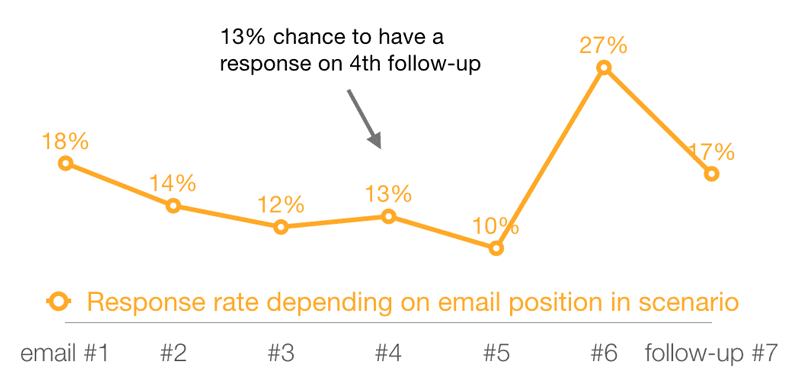Introducing
Win Them Back. Follow Up Email Strategy After No Response

It’s an empty feeling, isn’t it? You send an email, wait… and crickets. We’re all a bit shy about sending a follow up email after no response. Believe it or not, even the big brands can feel this way, and they fall into the same traps that limit business opportunity.
So what’s the best approach to follow up emails? Let’s find out.
How Many Times Should You Send?
First of all, let’s get free from that email no response anxiety. Obviously, people don’t like spam, but if your lead is truly viable, then they might not have responded because they’re busy. Think about it. How many emails have you received in the last week that caught your eye, but you just didn’t have the time to open?
How many emails does it take to get them to respond? One study showed that response rates remain relatively flat after sending about 4-5 follow up emails. The amazing thing is that their response rate shot up to 27% on email number six.

Other data shows that 92% of sales people give up after four "no's", and only 8% keep going after five or more no replies.
Best practice: Try at least 5-6 emails before giving up on a lead. Try going back to those who don’t answer in a month or so.
When should you send a follow up email?
While there’s no real data on the timing of follow up emails, some common sense comes into play. Most experts recommend three days as the sweet spot to reach out again. One week might be the maximum.
A lot of this depends on your type of lead. A ‘no response’ to a cold call may warrant a shorter follow up time. If the lead is warm, you might stretch it out to five days. You don’t want to sound desperate, but you don’t want the lead to go stale either.
Most recommend Tuesday, Wednesday and Thursday as the best days to get opens. However, a Friday email to a hot lead might be worth a shot, especially if you’re butting up against the five day limit.
Best practice: Send follow up emails after waiting three days and no more than five.
Keep It Fresh
One big mistake you must avoid is sending the exact same email as a follow up. Subject lines, content and closings should be modified every time. Remember, if they read your email, but didn’t contact you, at least they were interested. The next email should continue to create interest with new content. Nothing says spam more than the same email over and over again.
Best practice: Every email you send should be original.
Establish A Firm Close
Most marketers know all about calls to action, but on emails they might drop the ball. These kind of flimsy closings don’t cut it:
- I look forward to hearing from you.
- Let’s keep in touch.
- Let me know if I can be of assistance.
Instead, go for something more solid like:
- Would you like to set up a call next week?
- Please give me some feedback on this.
- Can we set up a demo in the next few days?
If your email has a clickable link, then tell them to click on it, just like any call to action:
- Learn more
- Get more info
- Dive deeper
Best practice: Close every email with a clear, decisive CTA.
Be Transparent & Sincere
There are some brands out there that resort to mind tricks to get people to open their emails. While this might increase open rates, it can damage your credibility and reputation. Avoid subject lines like:
- Following up on our phone call
- You asked me to get back to you
- Re: Our meeting last week
Now if you did speak or meet with a prospect, these subject lines are fine. But you did not meet, don’t make yourself look shady.
Instead, you might try follow up subject lines or content phrases like:
- Reaching out again
- Can we touch base?
- Just making sure you saw this
As you can see, these transmit a similar tone of closeness, but they don’t deceive the recipient in any way.
Best practice: Be honest.
Breaking Up Is Hard to Do. So Don’t Do It.
While there is some debate on this topic, it might not be in your best interest to send a break up email. However, some creative thinking may allow you to leverage this theme. For instance, you might send a subject line like:
- Are we breaking up already?
But when it comes to the email content, you don’t really end the relationship. You can talk about other offers, perks, events, anything… but don’t cut ties completely. If your prospect unsubscribes, then yes, it’s over. If not, let things cool down for a month or two and try to woo them back again.
Best practice: Don’t give up on any prospect unless they give up on you.
Follow Up With Value
While this is a great rule to follow for nearly any email, follow ups that provide extra value can see better response rates. Everybody likes freebies, so you might include a free report about a theme of interest. Maybe you can tempt them with a free demo or video content. Or you might give a discount on your initial offer. These kinds of incentives up the ante making it harder for them to resist.
Best practice: Follow up with a deal they can’t refuse.
Stay Positive
Email outreach and marketing is a tough game, and you might be tempted to get negative or pushy. Nothing will tank your response rates more than a negative vibe though. Who wants to work with a grouch? Instead, keep it as upbeat as possible. Avoid begging or complaining at all costs. For instance, try lines like:
- Just a nudge.
- Circling back on this thread.
- I want to make sure I’m not getting behind on this.
These friendly reminders get attention, but they don’t put emotional pressure on anyone.
Best practice: Don’t be grumpy. Instead, be the kind of person you want to be around.